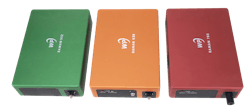Wasatch Photonics is excited to announce its new flagship line of compact Raman spectrometers and systems. The WP Raman X series is the most powerful, comprehensive compact Raman product line ever created, with superior sensitivity and flexibility to serve the needs of researchers and OEM instrument developers alike. The X series product family includes modular spectrometers, integrated lasers, complete Raman spectroscopy systems, and OEM modules from 532-1064 nm, configurable to the needs of each application. It has been designed with a singular goal – to accelerate the development of new applications of Raman and bring them to life.
The X series replaces the company’s line of WP Raman spectrometers used widely in medical diagnostics, materials research, food quality, security, authentication, and the environment. The new line leverages Wasatch Photonics’ patented VPH gratings, signature sensitivity, and highly robust and reproducible optical bench – now refined for ease of manufacture with a configurable, unified optomechanical design. This allows for a high degree of customization for research and/or prototyping, backed by scalability to high volumes in the company’s recently expanded US manufacturing facility.
Sensitive, configurable design:
The X series includes Raman spectrometers and systems for use at 532, 638, 785, 830, and 1064 nm excitation, covering the fingerprint and functional range of Raman peaks with 10 cm-1 resolution or better. Wasatch Photonics’ Raman products use a high NA optical design combined with in-house high efficiency VPH transmission gratings for superior signal collection and high throughput, delivering sensitivity approaching that of high-end Raman systems at a fraction of the size and cost.
Configuration options include a choice of f/1.3 or f/1.8 input aperture, detector cooling level, slit size, and sample coupling. Models available include: 1) standalone spectrometers for modular Raman spectroscopy, 2) spectrometers with integrated excitation laser to reduce size, cabling and cost, 3) fully integrated Raman systems for maximum signal in the smallest footprint, and 4) OEM versions of each to reduce size, weight, and cost in volume. These options allow the user to balance signal, resolution, range, and form factor according to the unique needs of their application. Data collection and spectrometer control is included through the company’s own ENLIGHTEN™ operating software and software development kits for C/C++, C#, Python, LabVIEW, MATLAB, and other languages.
Designed to accelerate OEM product development:
The X series was created using DFM (design for manufacturing) principles, resulting in a unified optomechanical design that serves the needs of both researchers and application-specific instrument manufacturers (OEMs). By leveraging the same robust, highly reproducible optical bench, users can complete proof-of-concept and method development with a fully housed unit, then transition directly to the corresponding OEM module for identical performance in volume, using the same matching libraries/chemometric models. This is a key advantage for aspiring university spin-offs and startups seeking to maximize velocity and conserve resources.
The X series’ ‘OEM by design’ approach ensures consistent performance at every stage, allowing OEMs to transition easily and confidently from research to product development faster, more efficiently, and with lower risk. All X series OEM modules, 532-1064 nm, are supported by a team of product and application specialists, open-source software, raw data access, and GitHub resources to simplify software development.
“The X series started with a question – What does the future of Raman look like?” says Dr. David Creasey, CEO of Wasatch Photonics. “Raman is well established in hazmat detection and pharma, and now it’s starting to take off in medical diagnostics and similar bioanalysis, pioneered by innovators who see its potential to provide very specific answers to complex questions. We created the X series to give them the sensitivity, reproducibility, and configurability they need to answer these questions with confidence, and to bring their solutions to market more rapidly.”
Wasatch Photonics’ new X series Raman spectrometers and systems are available for immediate sale in both laboratory and OEM modules. They can be configured for 532, 638, 785, 830, and 1064 nm Raman spectroscopy, supported by a full line of compatible user-configurable Raman probes and open-source software. The X series will be on exhibit throughout the coming year at SPIE BiOS/Photonics West, Spring SciX, and the FACSS SciX conferences.
About Wasatch Photonics:
Founded in 2002, Wasatch Photonics designs, manufactures and markets high-sensitivity compact spectrometers and systems designed specifically for Raman spectroscopy based on its own patented high efficiency volume phase holographic (VPH) gratings. The company also offers VPH gratings for pulse compression, astronomy, spectroscopy, spectral imaging, and optical coherence tomography (OCT), as well spectrometers and systems for OCT. Our high-performance VPH gratings, spectrometers, and systems can be found in research labs all over the world. We also work extensively with OEM partners spanning a diverse range of industries, including defense and security, chemical manufacturing, pharmaceutical, medical, energy, education, computer, and electronics sectors. To learn more about us, please visit www.wasatchphotonics.com.
Sponsored Recommendations
Sponsored Recommendations
Request a free Micro 3D Printed sample part
April 11, 2024
How to Tune Servo Systems: The Basics
April 10, 2024
Voice your opinion!
Voice your opinion!
